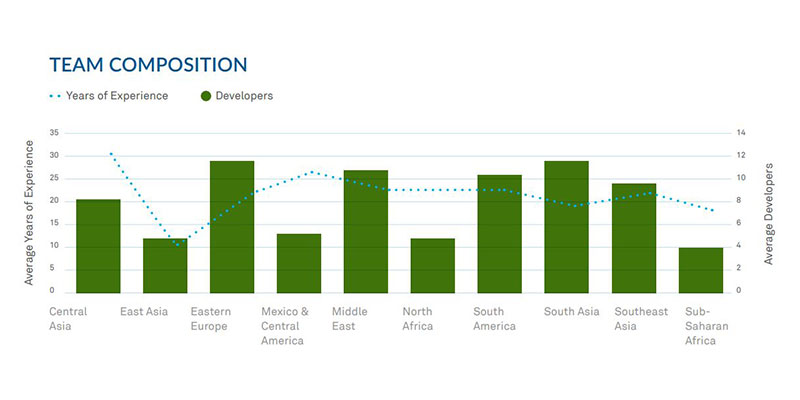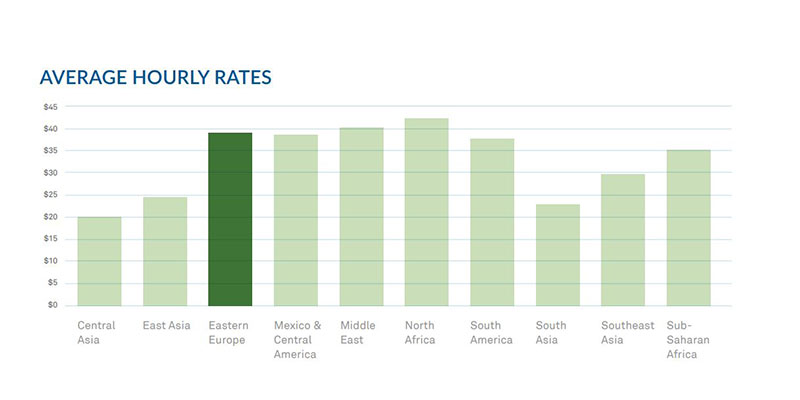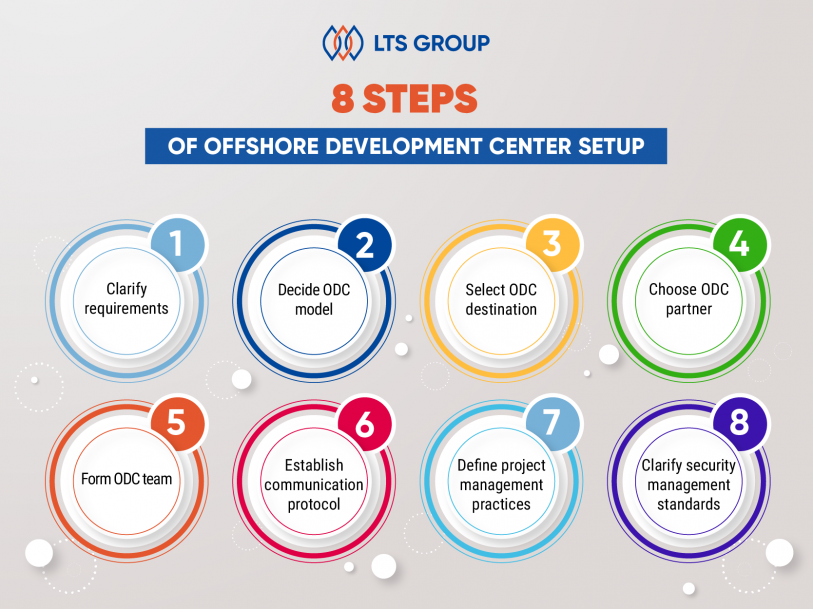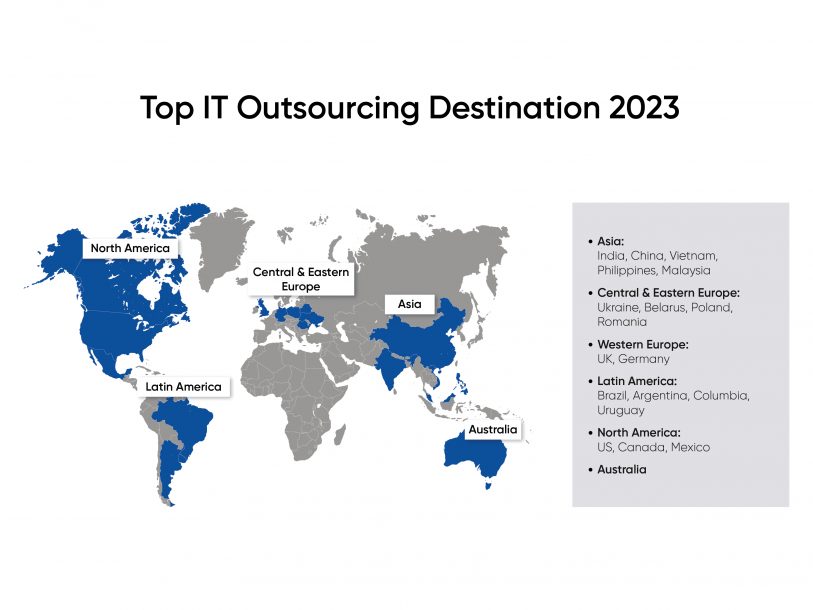Since the pandemic taking its toll on the world, we have witnessed the screeching halt of the world’s finance and economy. Even the most prominent players in the market are doing everything they can to cut down costs. As in the IT industry, the most exploitable approach is perhaps Offshore Development Center, or we often call it ODC.
The term “Offshore Development Center” may not be that familiar to some businesses. However, this has been adopted in multiple fields of the IT industry and gaining its reputation as a cost-effective, approachable way of IT Outsourcing.
So, if you are taking the first steps toward offshore development, take a tour with us to gain an overview of ODC.
1. What is Offshore Development Center?
Offshore Development Center, short as ODC, is a form of IT Outsourcing that entails the creation of a dedicated off-site team located in another country to work on your software development project. Simply put, you are using software development services of an oversea country. The three main points of an ODC are:
- Scalability
- Dedication
- Integration
For an ODC, the resources included will be the human resources and infrastructure. Although the name says for itself the purpose of this off-site team, which is software development, the ODC can also include administrative and supporting staff, all depending on your requests.
Here is an invaluable guide to software development for business owners, check it out!

What is an Offshore Development Center?
Since it is a “Center”, an ODC is often for large-scale and long-term operations. How you manage it lies upon your resources on a management team. It could be a single project manager working on-site covering all the monitoring, reports and assessment, or it could be a team of tech engineers from your side.
An Offshore Development Center may consist of some to tens of people. They can either work on the same project or on different projects. This varies on how much you want this ODC to cover the information technology aspect of your operation.
2. Offshore Development Center vs. IT Outsourcing: Aren’t they the same?
Some might mistake IT Outsourcing with Offshore Development Center. Actually, Offshore Development Center is just a form of IT Outsourcing. While IT Outsourcing pays no regard to location, Offshore Development Center refers explicitly to the offshore operation of the projects.
For an IT Outsourcing project, its core should be the output, while how the outsourcing team produces that output is just a minor factor. The client has no or little control over the project specifics. In contrast, since the ODC acts as a branch of the business, it should follow the company’s guidelines and code of conduct. An ODC can function as a branch or an IT department of one business, dealing with every technical matter of that business.
Thanks to geographical pricing, the gap between labor costs in some countries is higher than in some other countries. Exploiting this trait, many enterprises can now hire talents with the same capabilities at a much lower expense when applying ODC. One extra task for enterprises using this model is to have a project manager supervise the project.
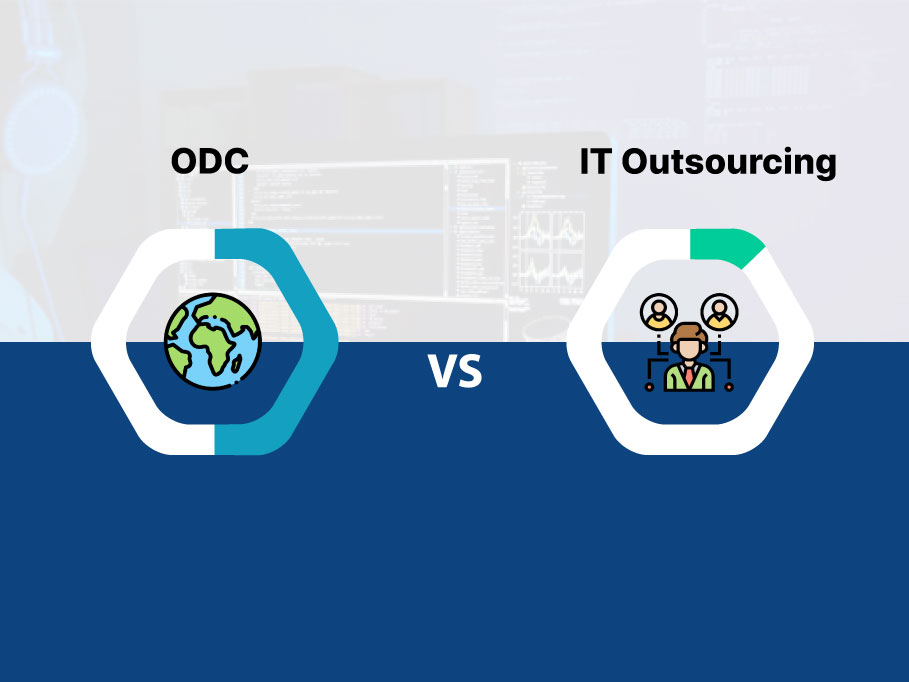
Offshore Development Center vs. IT Outsourcing
For anyone who doesn’t know whether ODC or IT outsourcing is suitable for your business purpose, you can consider this:
- IT Outsourcing focuses on the output of the project. Therefore, the cost is a minor factor. As long as the requirements are met, you have no problems in the limited control of you in the team. The personnel of the IT Outsourcing team can change over time. For each IT Outsourcing team, they usually just work on one particular project. For another project, another team or contract is set up.
- Offshore Development Center’s core priority is cost reduction. Plus, the management within the project is stricter, with the client hiring extra personnel solely for management and supervision. ODC can work on multiple projects at the same time.
3. What can Offshore Development Center bring to your business?
Yes, IT Outsourcing and Offshore Development Center are two different models, and yes, IT Outsourcing is a more popular choice for businesses. However, Offshore Development does hold some beneficial traits that can contribute to your business:
- Cost reduction
- Close-up management and supervision
- Access to a large talent pool
- Market expansion
- Diverse team of technical engineers
- Continuous maintenance – Avoid knowledge releasing
- Alignment with client’s objectives
Cost reduction
The main reason why one business considers Offshore Development Center is the cost reduction it can offer. As mentioned before, the labor cost and other infrastructure costs vary from country to country. This is geographical pricing. With this glaring gap, many enterprises see the opportunity in which they can have a team with the same capabilities and proficiencies at a much lower cost.
Talking about ODC cost, it includes the initial cost to set up an ODC and the cost for operation. Let’s look at our calculation on running a domestic software team vs. an ODC software team.
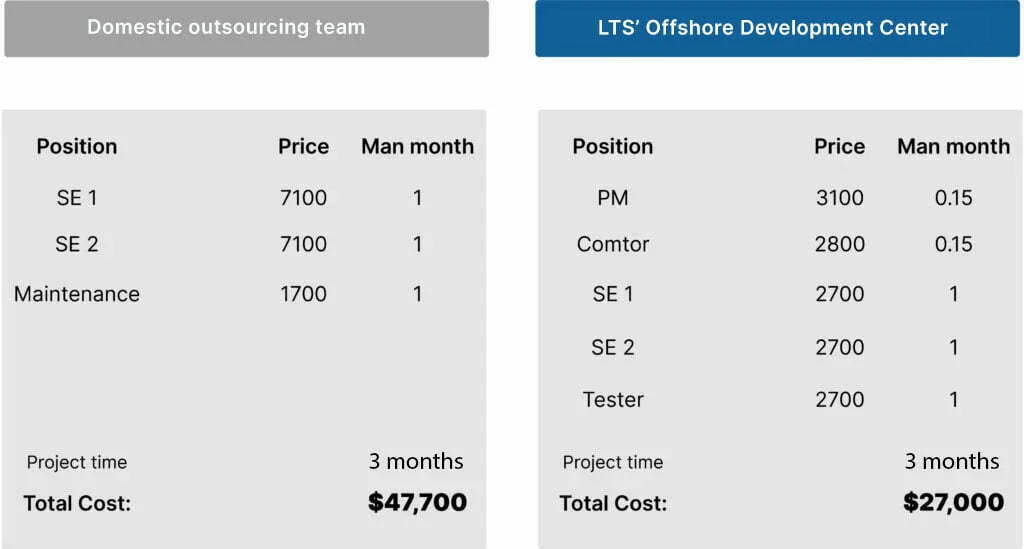
Cost comparision between Onshoring and Offshore development center
Close-up management and supervision
The fear of loose management and inadequate supervision might be one daunting factor for businesses wanting to apply Offshore Development Center. However, the reality proved the other way round.
Over many years, the management method of Offshore Development Center now works in a functional way, including the stringent procedures and close step-by-step supervision within each project team.
And don’t forget about the increasing number of QA & QC staff working in an ODC. For example, each ODC project will be assigned with at least one QA and 2 QC employees to keep track of the work. In addition, Project Manager will be in charge of the whole operations through daily reports and constant updates.
Access to a large talent pool
Besides the leading factor of reduced costs, Offshore Development also holds another great benefit of a large talent resource, both in quantity and quality. When it comes to building the traditional in-house team, the recruitment cost goes through the roof with many trivial spending. Candidates don’t appear out of thin air. Corporations have to spend quite a fortune on ads, training efforts, orientations, etc.
aking advantage of this reality, companies providing ODC services always try to work through an effective recruitment process and training programs to sharpen IT staff’s skills, to to constantly adapt to the market’s demand and bring as much diversity to the project as possible.
Market expansion
With Offshore development services, companies now can expand their market in two manners:
- Form a new branch in an oversea market and get closer to their customers – a subsidiary for market expansion.
- Extend service capabilities, enhance customer experiences, reach more markets.
With ODC, as long as you find the right offshore development vendor and agree on the right way to engage with the process, raising business capabilities to expand the market is no longer a significant concern.
Continuous maintenance – Avoid knowledge releasing
With an offshore development team, you get a long-term dedicated team to take care of the entire cycle of the project and avoid knowledge releasing – the lack of people well-understanding your product/service for maintenance and upgrade.
The trend now is continuous maintenance performed on a weekly or even daily basis. First, each employees’ work is logged onto the management file, clearly stating what has been done. Then, the QC, QA and PM will take turns to check and verify their work. Finally, if anything goes wrong, the one held responsible will fix the problems. This is the process applied widely in the market and has proven its effectiveness.
During the entire cycle of the project, ODC uses every resource they have to complete their tasks. But, even in that case, there might be some time that the results don’t live up to your expectations. This is another reason for the continuous maintenance of your project. With instant maintenance after each step, the time-to-fix and time-to-market are reduced to their minimum.

Continuous Maintenance with Offshore Development Center
Alignment with client’s objectives
For an ODC to function properly, you cannot leave out the position of Business Analysts. With this personnel, the mutual understanding between the ODC and client is more clearly clarified. Transparent requirements, along with advice from an expert in business development, can help you a great deal in finding the best work model to with.
With mutual understanding, ODC can now align with the client’s objectives and make any more adjustments if needed.
4. Domains for ODC: electronics, automotive & healthcare
Offshore Development Center is being applied throughout the world. Information Technology is the universal requirement for any business to adapt to the current preferences of society. We’re used to the pervading use of technology in entertainment and utilities, but the market is much bigger than that. Instead of the direct interaction with technology through apps and social media platforms, we now can see the increasing use of technology in multiple industrial and service sectors. The most obvious domains can be counted as:
- Electronics
- Automotive
- Healthcare
Electronics and Embedded Software
The “Smart” concept is more popular than ever, with embedded software implementation on every electronic device manufactured. For one electronic device, the modern world’s consumers not only care about the core functions of the device but also have a preference for the “high-tech” feature of the device. For example, an electronic fan is not enough. This fan has to obtain the “smart” feature and be a part of the manufacturer’s ecosystem. We have seen this in the case of Xiaomi. This new player in the technology marketplace of China has manifested the favor of consumers when it comes to electronic devices through its success with Mi home – a new ecosystem of home electronic devices.

Offshore Development Center for Embedded Software
Through this example, we can see the undeniable growth of IT in the electronics manufacturing field. With a large number of devices to put on the market every year, not to mention the updates and upgrades of the embedded software, the demand for electronics embedded software is higher than ever.
On the contrary, the supply of infrastructure and especially human resources within one country for this growth is still very limited. Hence, the electronics manufacturers have to come for IT Outsourcing, or even Offshore Development Center to seek help.
Instead of simple IT Outsourcing, manufacturers often go for Offshore Development Center for better security.
Automotive
It is almost like a tradition for the automotive industry to outsource its production (with an outsourcing rate of 80%), and the information technology aspect is no exception.

Offshore Development Center with Automotive
The widespread usage of digital sources and appliances has influenced how automakers wish to update current models. With customer-centricity, anything that benefits their consumers is designed to apply in the vehicles, such as automated automobiles, AI systems in customer service, and virtual assistants, the manufacturers, the adoption of an ODC can improve the security of the project, which is now bound the legal agreements.
Healthcare
From 2020 to 2027, IT Outsourcing in Healthcare and Medical is expected to grow at a CAGR of 11%. The rate for the rise of Offshore Development Center is approximately the same.
With the pandemic taking its toll on the world and the outburst of many other diseases, the medical and healthcare system needs more than what they have now to provide the best services.
Besides the clinical demands for each doctor and health worker, the world needs utilities and other technical advances to deliver conveniences to the health workers and the patients.
Since the technical system often requires highly competent staff, the demand for this is increasing. However, their core business development was never the technology. It is the overall experience of one customer and the treatment process that matter to them. The point is, for the best services, IT is indispensable.
For this reason, healthcare is another eminent domain for IT Outsourcing, especially Offshore Development to grow on.
5. ODC Checklist – Three keys to launching your ODC
Got Offshore Development Center in mind? This is just the first step. In fact, the world’s market has witnessed many failed cases, all of which lack the consideration of the following Offshore development center checklist:
- The right country for your offshore software development center
- The suitable team structure for your project and management style
- The right ODC pricing model for your project
The country in which you want to set up the ODC
The top destination for IT Outsourcing or Offshore Development Center used to be in Eastern Asia, with China, Japan and Korea reign as the most popular ones. However, in recent years, the labor cost in these countries has increased to the point that they’re no longer the favored destinations for Offshore Development Center.
Instead, Southern Asia and South-East Asia countries’ Offshore Development Center service is developing at a staggering speed. Standing out in these countries, Vietnam reigns top countries for ODC setup. According to the U.S. News, Vietnam scores 100/100 for Cheap manufacturing costs globally and is the 2nd-lowest operation cost country in Asia. Also, the legal infrastructure of Vietnam for the IT sector is also supportive, with tax reduction/exemption, land rental exemption, and other favored policies.
Apart from the Southern Asia and South-East Asia, companies can consider Australia, Newzealand, The Philippines, Poland, and Argentina for ODC.

Choosing a country to set up an Offshore Development Center
The suitable team structure for your project and management style
Team structure in an Offshore Development team varies according to the client’s requirements. But the major roles include:
- Account Manager: This person is like the focal point of communication between two parties of the client and the ODC. They take in your requirements and deliver them to the project manager and the development team
- Project Manager: This person specializes in managerial skills and technical skills to carry out planning and executing, making sure the client’s requirements are met.
- Developers: They are like worker bees working on different tasks of one project. The installation, testing, and maintenance process may be involved in the work, depending on the client’s requirements.
The ODC model for your project
The pricing model of Offshore Development is quite diverse, especially with the ever-changing market of the IT industry. However, there are two most popular models of Offshore Development Center as below.
– Dedicated Offshore Development Center:
Taking from its name, a dedicated offshore development center gives the client the whole fully functioning team. This team can act up as the client’s other subsidiary/branch that specifically works on the development and their IT-related tasks. This model is for large projects with undefined requirements, meaning that the team will work their way out during the work process. The client will pay upon the onboard time of the team.
– Build – Operate – Transfer:
This BOT model can be considered a more advanced price model of Offshore Development Center in general. During the work process, the Offshore team will be responsible for Development (in “Build”) for Implementation (in “Operate). Once the client wants to take over everything, they will sign a contract for further purchase and other legal matters.
This BOT model is also for large projects, and especially for companies wanting to enter the market of hosting countries.
Whether you choose Dedicated Offshore Development Center or Build-Operate-Transfer, there will be a lot of things you have to take into consideration for the best interest of your company.
Final Notes
With all of the above information on Offshore Development Center, you can grasp the basic idea of how this works and how it can benefit your business. If you’re swamped with too much knowledge of this, you can learn about our Offshore development services or contact our expert for a free consultation.
Contact us at:











